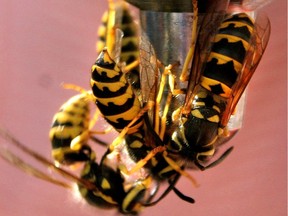There have been anecdotal reports of larger-than-normal wasp populations in certain parts of Canada in recent weeks — Alberta is abuzz as are the Prairies

Spend any amount of time outside around this time of year in most of Canada, you’re likely to be besieged by wasps.
Early fall gardening? Give the hungry pollinators space.
Enjoying a sunny post-work tall boy on the deck? Check that a wasp hasn’t found its way into your can for a sip.
Even trying to approach garbage comes with the real threat of being swarmed by the winged menaces.
But what is it about late summer and early fall that makes wasps so ubiquitous and so seemingly angry?
Motivated by food, not hate
The yellow jacket wasps most Canadians are accustomed to are one of several non-native species of somewhat ironically named social wasps — meaning they live in a community in which they work together to build and defend the nest, hunt for food and raise the young.
Come late summer and early fall, the nest is home to several hundred worker wasps charged with feeding themselves and the queen wasp’s final batch of eggs before winter, eggs destined to become the next generation of queens and unfertilized drones.
“But the numbers of workers that are being produced is actually starting to decline because they aren’t being reared anymore. So, you’ve got huge food demands with smaller numbers to do the feeding.”
Don’t pick a fight
Given how hungry they are, they’ll go after just about anything — including the food on your plate and the drink in your glass.
When this happens, Otis’ advice is to not freak out. While wasps aren’t necessarily looking for a fight, they won’t back down.
“If you don’t swing at them … for the most part, they’re just gonna completely leave you alone,” he says. “Even if they’re coming and foraging for food on your table, you can take your hand and gently wave it past where they are and move them out of the area without disturbing them.”

As social creatures, they stick up for their own. Start flailing to take one down and it’s likely to release an alarm pheromone calling nearby allies into battle. The same chemical is also released when a sting is landed.
Otis, who is often stung in his line of work, has a pro tip for quickly eliminating the threat of more attacks.
“The first thing I do is lick my fingers on one hand and then wipe the spot with my wet fingers because that will help to remove the water-based pheromone and prevent the target that’s sitting there waiting to attract other wasps to sting the same spot.”
Eco-workers
As much as humans may deplore them infringing on our time outside, wasps are an important part of the ecosystem.
They’re a food source for some mammals, play a role in natural pollination and hunt flies and insects.
“They do a pretty good job of biocontrol of some pest insects on some crops,” adds Otis. “Probably not enough to completely eliminate the pest, but they’re definitely aiding in the removal of insects you would consider harmful to some of the plants you’d be growing.
In his mind, the idea of “bad” or “good” years for wasps is mostly all in our heads.
“People forget what it was like the previous year and a lot of wasps show up and they go, “Oh, this is the worst I’ve ever seen it.’”

Preventing pain
Wasps are ravenous right now and while their instinct is to hunt for protein-rich foods, they’ve got a sweet tooth and are attracted to strong scents — so mind your pumpkin spice lattes, folks.
Their attraction to scents also applies to colognes, perfumes and hair products. Garbage cans and dumpsters, meanwhile, present a veritable buffet.
Otis says the fake nests used by some restaurants offer little deterrence — “They might give you peace of mind and make you think you’re doing something,” he says — and the use of baited traps on the sidewalk patio, but away from guests is, in his view, a fool’s errand.
“If you attract a whole lot more wasps to the area, they’re all hungry, they’re going to start looking around and they’re going to find where you are.”
The government agency suggests using “protein foods (like dog food) instead of sweet foods so that bees are not trapped” with their pollinating counterparts.
A more militant strategy involves taking the fight to the wasps with chemical sprays designed to kill a safely accessible nest.
This approach is best attempted on a cool night when the wasps are at rest and using a red filter over a flashlight so as to not disturb them.
“You don’t want to do this in the middle of the day when it’s warm and they’re out flying around because then they get pretty angry,” says Otis, who notes the closer you can get with the bug bomb, the more of them will die.
Our website is the place for the latest breaking news, exclusive scoops, longreads and provocative commentary. Please bookmark nationalpost.com and sign up for our newsletters here.